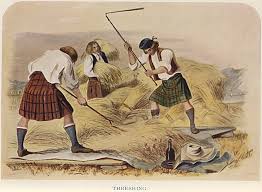The fairies were in the habit of giving a helping hand to their favourites. A farmer had a noted thresher of his grain crop. Before the invention of threshing mills, and for long after, even till thirty years ago, it was the usual way for the men of the farm to get out of bed by three or four o’clock in the morning, thresh with the flail enough to serve for the day, and be ready by the stated hour to begin the day’s labour. This noted thresher had got into the favour of the fairies, and he hlad but to call and they were at his service when he went to the barn to do his threshing in the morning. His master began to suspect there was something more than mortal power at the bottom of his servant’s success as a thresher. He resolved to find out; and one morning he secreted himself in the barn before the hour of threshing came, so as to have a full view of what would go on at the threshing floor. The thresher appeared at the usual time, trimmed his lamp, placed the sheaves on the floor (usually two), and laid hold on the flail. Before beginning, he looked round, and said: ‘Come awa, ma reed-caippies.’ In an instant the sheaves began to tumble from ‘the moo’ into the threshing-floor, and the fairiesw ere hard at work, and soon finished the day’s threshing. The master waited till the whole was quiet, and the thresher had left the barn. He said nothing to him of what he had seen, but he parted with him on the first favourable opportunity Gregor, Walter ‘Stories of Fairies from Scotland’ The Folk-Lore Journal 1 (1883), 25-27 at 27


